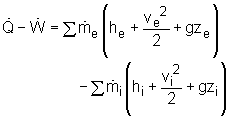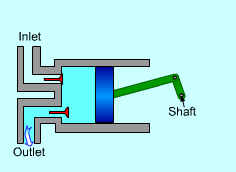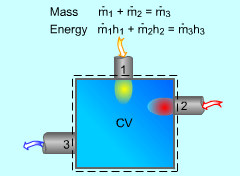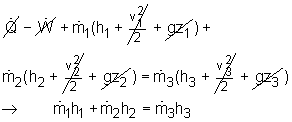| Ch 4. Energy Analysis | Multimedia Engineering Thermodynamics | ||||||
|
Steady-flow Process |
Steady-flow Devices (1) |
Steady-flow Devices (2) |
Steady-flow Devices (3) |
Unsteady-flow Process |
|||
| Steady-flow Devices (2) | Case Intro | Theory | Case Solution |
| Chapter |
| 1. Basics |
| 2. Pure Substances |
| 3. First Law |
| 4. Energy Analysis |
| 5. Second Law |
| 6. Entropy |
| 7. Exergy Analysis |
| 8. Gas Power Cyc |
| 9. Brayton Cycle |
| 10. Rankine Cycle |
| Appendix |
| Basic Math |
| Units |
| Thermo Tables |
| Search |
| eBooks |
| Dynamics |
| Fluids |
| Math |
| Mechanics |
| Statics |
| Thermodynamics |
| Author(s): |
| Meirong Huang |
| Kurt Gramoll |
| ©Kurt Gramoll |
| |
||
Many engineering devices operate essentially under the same conditions for long periods of time. Therefore, these devices can be treated as steady-flow devices. Recall, the energy balance for a control volume is: |
||
| Turbines, Compressors, and Pumps |
||
|
|
In steam, gas or hydroelectric power plants, the device that drives the electric generator is the turbine. A turbine is a device in which work is developed as a result of a gas or liquid passing through a set of blades. The blades, which are attached to the shaft, force the shaft to rotate. The work is positive since it is done by the fluid. Compressors are devices which raise the pressure of the gas that passes through them. In pumps, the working fluid is a liquid instead of a gas. Work is supplied to these devices through a rotating shaft from an external source. There are several common assumptions that are made in the energy analysis of turbines and compressors:
|
|
| Mixing Chambers |
||
|
|
In engineering applications, the steady-flow mixing of two streams of the same fluid is another common process. The section where the mixing process takes place is referred to as a mixing chamber. An open feedwater heater is an example of mixing chamber. If 1 and 2 denote the inlets and 3 denotes the exit, a mass balance gives There are several common assumptions that are made in the energy analysis of mixture chambers:
Hence, the energy balance for mixing chamber is: |
|




